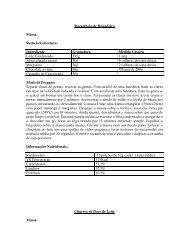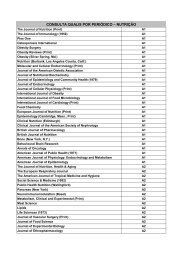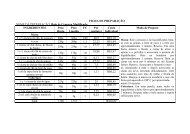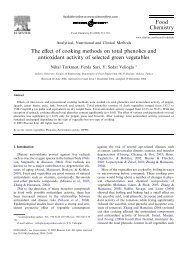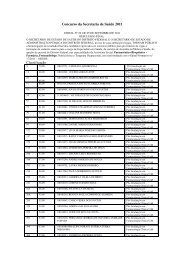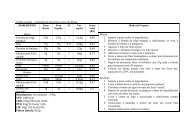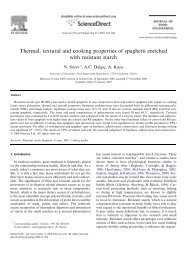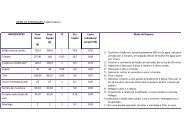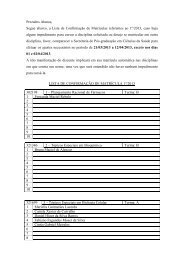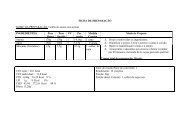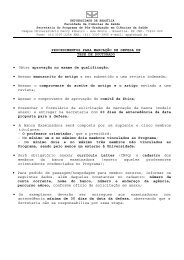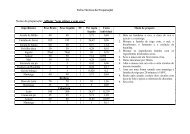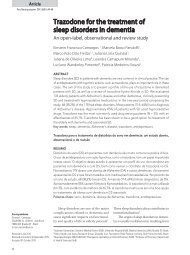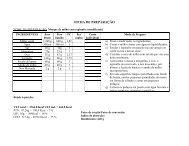Impact of different cooking methods on food quality: Retention of ...
Impact of different cooking methods on food quality: Retention of ...
Impact of different cooking methods on food quality: Retention of ...
You also want an ePaper? Increase the reach of your titles
YUMPU automatically turns print PDFs into web optimized ePapers that Google loves.
330 S. Bernhardt, E. Schlich / Journal <str<strong>on</strong>g>of</str<strong>on</strong>g> Food Engineering 77 (2006) 327–333<br />
Table 5<br />
b-Carotene and a-tocopherol c<strong>on</strong>tents (mg/100 g) in frozen red pepper ðx SDÞ (Loh, 2004)<br />
Before <str<strong>on</strong>g>cooking</str<strong>on</strong>g> Boiling Steaming Microwave<br />
All-trans-b-carotene 0.90 ± 0.06 0.68 ± 0.04 0.78 ± 0.10 0.72 ± 0.09<br />
Cis-b-carotene 0.18 ± 0.04 0.27 ± 0.03 0.28 ± 0.05 0.17 ± 0.02<br />
a-tocopherol 4.48 ± 0.11 4.62 ± 0.06 4.29 ± 0.31 4.65 ± 0.17<br />
3.1. b-Carotene<br />
All <str<strong>on</strong>g>cooking</str<strong>on</strong>g> <str<strong>on</strong>g>methods</str<strong>on</strong>g> lead to a significant release <str<strong>on</strong>g>of</str<strong>on</strong>g><br />
all-trans-b-carotene and its cis-isomers in fresh broccoli.<br />
Similar results have already been reported by Hart and<br />
Lessin in cooked broccoli and by Howard in microwaved<br />
broccoli (Hart & Scott, 1995; Howard et al., 1999;<br />
Lessin, Catigani, & Schwartz, 1997). Previous own investigati<strong>on</strong>s<br />
have already shown a release <str<strong>on</strong>g>of</str<strong>on</strong>g> b-carotene in<br />
fresh broccoli prepared with <str<strong>on</strong>g>different</str<strong>on</strong>g> <str<strong>on</strong>g>cooking</str<strong>on</strong>g> <str<strong>on</strong>g>methods</str<strong>on</strong>g><br />
(Schlich, Boeker, Dietrich, Loh, & Ziems, 2001).<br />
In broccoli b-carotene is incorporated in the carotenoid–protein-complexes<br />
in the chloroplasts. These socalled<br />
carotenoproteins have an inhibitory effect <strong>on</strong><br />
extractability <str<strong>on</strong>g>of</str<strong>on</strong>g> b-carotene from the vegetable matrix.<br />
Cooking leads to a s<str<strong>on</strong>g>of</str<strong>on</strong>g>tening <str<strong>on</strong>g>of</str<strong>on</strong>g> the plant tissue and<br />
the denaturati<strong>on</strong> <str<strong>on</strong>g>of</str<strong>on</strong>g> proteins so that the carotenoids<br />
can be extracted a lot easier (Rodriguez-Amaya, 1997).<br />
It is assumed that an increased extractability may be<br />
associated with improved bioavailability (Erdmann<br />
et al., 1988).<br />
In frozen broccoli all <str<strong>on</strong>g>cooking</str<strong>on</strong>g> <str<strong>on</strong>g>methods</str<strong>on</strong>g> led to significant<br />
losses <str<strong>on</strong>g>of</str<strong>on</strong>g> all-trans-b-carotene, which range between<br />
14% and 25%. Broccoli was blanched before freezing.<br />
The blanching step leads already to a disrupti<strong>on</strong> <str<strong>on</strong>g>of</str<strong>on</strong>g> the<br />
cell membrane and a s<str<strong>on</strong>g>of</str<strong>on</strong>g>tening <str<strong>on</strong>g>of</str<strong>on</strong>g> the vegetable matrix<br />
(Herrmann, 1996). This causes already a better extractability<br />
<str<strong>on</strong>g>of</str<strong>on</strong>g> b-carotene so that higher c<strong>on</strong>tents can be<br />
proved (Oruña-C<strong>on</strong>cha, G<strong>on</strong>zález-Castro, Lopéz-<br />
Hernández, & Simal-Lozano, 1997). In the following<br />
<str<strong>on</strong>g>cooking</str<strong>on</strong>g> process no further release seems to be possible.<br />
In fresh red pepper stewing, steaming and pressure<br />
steaming lead to significant losses in all-trans-b-carotene<br />
c<strong>on</strong>tent. By viewing the average means it seems that also<br />
<str<strong>on</strong>g>cooking</str<strong>on</strong>g> leads to losses. A change in the cis-b-carotene<br />
c<strong>on</strong>tent cannot be proven. In frozen red pepper boiling<br />
and microwave <str<strong>on</strong>g>cooking</str<strong>on</strong>g> lead to significant losses <str<strong>on</strong>g>of</str<strong>on</strong>g><br />
all-trans-b-carotene. Only boiling leads to a significant<br />
increase <str<strong>on</strong>g>of</str<strong>on</strong>g> the cis-isomers.<br />
In summary it is shown that <str<strong>on</strong>g>cooking</str<strong>on</strong>g> has rather a negative<br />
effect <strong>on</strong> the b-carotene c<strong>on</strong>tent in fresh and frozen<br />
red pepper. The red pepper is a vegetable fruit, from<br />
botanical view it is a berry (Franke, 1997). In orange<br />
or red fruits b-carotene is dissolved in oil droplets in<br />
chromoplasts and can be better extracted than from<br />
green vegetables (Castenmiller & West, 1998; de Pee<br />
et al., 1998; Vishnevetsky et al., 1999). On the other<br />
hand it seems that in this form b-carotene is much more<br />
vulnerable against oxidati<strong>on</strong> which is the main reas<strong>on</strong><br />
for the destructi<strong>on</strong> <str<strong>on</strong>g>of</str<strong>on</strong>g> carotenoids (Rodriguez-Amaya,<br />
1997).<br />
To estimate better the effects <str<strong>on</strong>g>of</str<strong>on</strong>g> <str<strong>on</strong>g>cooking</str<strong>on</strong>g> <strong>on</strong> the alltrans-<br />
andcis-b-carotene c<strong>on</strong>tents the cis-/all-trans-ratio<br />
is calculated (Loh & Schlich, 2003). Therefore the c<strong>on</strong>tents<br />
<str<strong>on</strong>g>of</str<strong>on</strong>g> cis- and all-trans-b-carotene are set proporti<strong>on</strong>ally<br />
to each other into relati<strong>on</strong>ship (Table 6). In this way<br />
it is easier to recognise if and how the ratio from cis-bcarotene<br />
to all-trans-b-carotene changes after <str<strong>on</strong>g>cooking</str<strong>on</strong>g>.<br />
For visualisati<strong>on</strong> the arithmetic means are illustrated<br />
in Fig. 1.<br />
It strikes that by <str<strong>on</strong>g>cooking</str<strong>on</strong>g> fresh broccoli the ratio does<br />
not change respectively declines although you can observe<br />
a significant increase <str<strong>on</strong>g>of</str<strong>on</strong>g> the all-trans and the cisforms.<br />
This increase <str<strong>on</strong>g>of</str<strong>on</strong>g> the cis-isomers could probably<br />
be caused by the release <str<strong>on</strong>g>of</str<strong>on</strong>g> the natural in small amounts<br />
existing cis-forms and not by c<strong>on</strong>versi<strong>on</strong> <str<strong>on</strong>g>of</str<strong>on</strong>g> all-trans-bcarotene.<br />
Cooking <str<strong>on</strong>g>of</str<strong>on</strong>g> frozen broccoli does not lead to significant<br />
changes. The loss <str<strong>on</strong>g>of</str<strong>on</strong>g> all-trans-b-carotene by <str<strong>on</strong>g>cooking</str<strong>on</strong>g><br />
fresh and frozen red pepper is nearly always<br />
combined with a significant increase <str<strong>on</strong>g>of</str<strong>on</strong>g> the ratio.<br />
This could be a further hint that <str<strong>on</strong>g>cooking</str<strong>on</strong>g> <str<strong>on</strong>g>of</str<strong>on</strong>g> fresh<br />
broccoli has positive effects because all-trans-b-carotene<br />
is released and the cis-/all-trans-ratio decreases. Whereas<br />
Table 6<br />
Cis-/all-trans-ratio (in %) in the vegetables ðx SDÞ (Loh, 2004)<br />
Before <str<strong>on</strong>g>cooking</str<strong>on</strong>g> Boiling Stewing Steaming Pressure steaming Microwave<br />
Broccoli, fresh 42.0 ± 17.6 36.7 ± 6.9 33.6 ± 3.4 33.3 ± 4.3 32.2 ± 3.6 n.d.<br />
Pepper, fresh 27.9 ± 3.47 54.9 ± 19.89 47.0 ± 5.52 42.1 ± 6.21 40.0 ± 1.66 n.d.<br />
Broccoli, frozen 24.6 ± 3.6 25.0 ± 4.4 n.d. 24.5 ± 3.3 n.d. 23.3 ± 4.1<br />
Pepper, frozen 20.3 ± 3.6 39.5 ± 3.4 n.d. 36.1 ± 3.2 n.d. 23.3 ± 2.0



